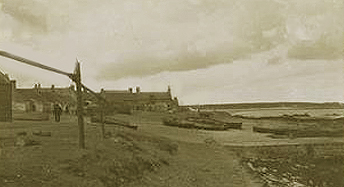The Sea
Lines and Nets by Greg D. Allen
The Line Fishing
Prior to and for a period after the herring boom of the mid 19th century line fishing was the principal method used by all fishermen carried on according to the seasons, for catching white fish, ie; haddock, cod, skate, ling and turbot.
The boats were wooden and undecked measuring from twenty three to thirty three feet in length. Each boat had a crew of six men; four to pull the oars, one to set the lines and one to land the catch. A mast and sail were aids on breezy days to freeing the oarsmen to assist in the onboard work.
The "Great Line" fishing took the boats as far a forty miles offshore necessitating a few uncomfortable nights at sea in all weathers. The "Small Line" fishing usually allowed the men to return the same day.
The lines in both types were of similar construction and the variations slight. The main line (the Back) consisted of a String, a thick piece of brown backed cord approximately sixty fathoms long (a fathom is a nautical measurement of six feet).
Attached to the String were Snoods - shorter pieces of thinner cord spaced at intervals of between thirty six to forty five inches along the line. To the Snoods were fixed horse hair Tippens, around eleven inches in length onto which the hook is whipped with strong thread. This is called "beating the hooks". The Snood is bent onto the line with a knot called a clove hitch and sufficient end left to turn back around to form a kind of plait. This prevents ravelling and twisting and is called a Pen.
The head of the line went over the side first, shot across the tide so that the Snoods would drift away from the main line and was anchored to the sea bed by a plain, unhooked line (a Tow), held in place by a heavy stone. A buoy marked the position of the Tow on the surface. The boat was allowed to drift for a time before hauling in the line to be stowed in a wicker scull or basket.

Boats on the shore at Buchanhaven c1900
Despite sharing a common occupation the methods had regional variations.
From Stonehaven to Fraserburgh the fishermen preferred to bait their lines
wet - a wet line, can be argued, was easier to shoot over the side. Along
the Moray Firth coast it was practical for ease and for the longevity of
the lines to hang them (made easier by hauling the lines back into the
sculls on the boat in bights) on a horizontal wooden pole (called a spiletree)
supported at one end by another pole, the other end resting on a stone
protruding from the gable end of the cottage. Spiletree stones can be seen
today on houses in Cairnbulg near Fraserburgh. Usually two, sometimes three
lines were kept allowing for at least one to be dried and baited whilst
the men were at sea.
back to top
The Herring Fishing
The herring fishing of the last century and well into the present brought new prosperity to the larger ports as well as offering employment for both the men and women of the smaller villages.
An important improvement in boat construction followed the rise of the herring drift netting. By 1880 the Zulu and Fifie, decked vessels with a keel length of between forty to fifty feet replaced their open decked counterparts, and came to be a familiar sight along the coast.
These boats carried up to sixty nets which were usually shot at dusk when the "silver darlings", as the herring were known, were swimming close to the surface. The boat would drift with the tide ensuring the nets were fully suspended and stretched - hence the term "drift netting". The hauling in was done by hand, the herring shaken out and stowed in the hold.
The women played a vital role in the herring fishery, often working long hours onshore, in all weathers, gutting, curing and packing the "silver darlings". They worked in squads - two gutters and a packer. Skilled gutters could clean an average of sixty to eighty herring per minute.
By the beginning of the twentieth century the women and girls followed the boats from station to station commencing on the west coast north to Caithness and down along the eastern coastline until the end of the season at Yarmouth in England.
The boom of 1913 was the peak of the Scottish fishing with over thirty thousand fishermen and nearly ten thousand boats catching over two hundred thousand tons of herring.

